
Soil Research
Scope & Guideline
Exploring the vital role of soil in our ecosystem.
Introduction
Aims and Scopes
- Soil Physicochemical Properties:
Research on the physical and chemical characteristics of soils, including studies on soil structure, composition, nutrient availability, and how these properties affect agricultural productivity and ecosystem health. - Soil Management Practices:
Investigations into various soil management strategies, such as conservation tillage, cover cropping, and organic amendments, aimed at improving soil health and productivity while minimizing environmental impacts. - Soil Microbiology and Ecology:
Studies that explore the diversity and function of soil microorganisms, their interactions with plants, and their roles in nutrient cycling, organic matter decomposition, and soil health. - Soil Erosion and Conservation:
Research examining the causes and effects of soil erosion, as well as strategies for soil conservation and restoration in agricultural and natural landscapes. - Climate Change Impacts on Soil:
Explorations of how climate change affects soil properties, processes, and functions, including studies on carbon sequestration and greenhouse gas emissions. - Soil Fertility and Nutrient Management:
Research focused on understanding nutrient dynamics in soils, including the effects of different fertilization regimes on soil fertility and crop yields.
Trending and Emerging
- Sustainable Agriculture Practices:
There is a strong emphasis on research related to sustainable agricultural practices, such as no-till farming, cover cropping, and the use of organic amendments, reflecting a broader interest in enhancing soil health while maintaining crop productivity. - Impact of Climate Change on Soil Dynamics:
Emerging studies are increasingly addressing the impacts of climate change on soil properties and processes, including soil carbon dynamics and greenhouse gas emissions, indicating a growing recognition of the need to understand these interactions. - Soil Health and Microbial Interactions:
Research on the relationships between soil health, microbial diversity, and ecosystem functions is gaining traction, highlighting the importance of soil biology in maintaining soil fertility and resilience. - Precision Agriculture and Soil Monitoring Technologies:
There is a notable increase in studies utilizing precision agriculture technologies, including digital soil mapping and sensor-based monitoring systems, to optimize soil management practices and improve agricultural outcomes. - Ecological Restoration and Soil Rehabilitation:
An emerging focus on soil rehabilitation and restoration practices, particularly in degraded and impacted landscapes, showcases the journal's commitment to addressing environmental sustainability and resilience.
Declining or Waning
- Traditional Soil Mapping Techniques:
There has been a noticeable decrease in studies focused on conventional soil mapping methodologies, likely due to the rise of advanced digital mapping technologies and remote sensing techniques that provide more efficient and accurate soil assessments. - Soil Contamination Studies:
Research addressing soil contamination from industrial and agricultural pollutants appears to be less frequent. This may indicate a shift towards more sustainable practices or a focus on remediation techniques rather than contamination assessment. - Historical Soil Studies:
Papers discussing historical soil profiles and long-term soil changes are less common, possibly as the field moves towards more contemporary and immediate applications of soil science in response to current environmental issues.
Similar Journals

Geoderma
Advancing Knowledge in Soil and Ecosystem DynamicsGeoderma is a leading academic journal published by ELSEVIER, focused on the vital field of Soil Science. With an impressive impact factor and ranking as Q1 in its category for 2023, this journal stands as a prominent platform for researchers and professionals seeking to explore advanced scientific studies related to soil and its relationships with the ecosystem. Covering a wide range of topics from soil formation and characterization to land use and management practices, Geoderma is recognized for its rigorous peer-review process and is highly regarded within the global scientific community, as evidenced by its ranking of #12 out of 159 in the Scopus categories of Agricultural and Biological Sciences and Soil Science, placing it in the top 92nd percentile. With its inception dating back to 1967, the journal continually adapts and converges its content to meet the evolving demands of soil research until 2024 and beyond, providing invaluable insights for students, professionals, and researchers alike.
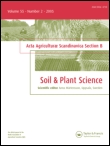
ACTA AGRICULTURAE SCANDINAVICA SECTION B-SOIL AND PLANT SCIENCE
Empowering Researchers to Shape Sustainable Agricultural PracticesACTA AGRICULTURAE SCANDINAVICA SECTION B-SOIL AND PLANT SCIENCE, published by Taylor & Francis AS, is a distinguished journal dedicated to the fields of Agronomy, Crop Science, and Soil Science. With an impressive impact factor, and categorized in Q2 for both Agronomy and Crop Science and Soil Science as of 2023, this journal is an essential resource for researchers, professionals, and students aiming to advance their understanding of soil-plant interactions and sustainable agricultural practices. Operating since 1992 and continuing through to 2024, ACTA aims to publish high-quality, peer-reviewed research that encourages the applicability of advanced scientific knowledge in real-world agricultural settings. While the journal is not open access, it remains widely accessible through institutional subscriptions, reflecting its commitment to disseminating essential findings and fostering innovation in soil and plant science worldwide. Nestled in the vibrant academic environment of Norway, ACTA AGRICULTURAE SCANDINAVICA serves as a key platform for nurturing groundbreaking research that informs sustainable agricultural policies and practices globally.
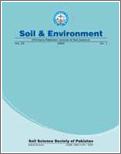
Soil & Environment
Advancing Sustainable Practices for a Healthier PlanetSoil & Environment is a distinguished open access journal published by the University of Agriculture, Institute of Soil & Environmental Sciences, located in Faisalabad, Pakistan. Established in 2006, this journal has become a vital platform for disseminating pioneering research in the fields of Environmental Science and Soil Science. With an ISSN of 2074-9546, it provides a wealth of knowledge through accessible academic articles, particularly focusing on sustainable practices and innovations that impact soil and environmental health. Although currently categorized in Q4 within both Environmental Science (miscellaneous) and Soil Science, the journal is dedicated to enhancing its influence and visibility as it progresses towards convergence years that span from 2010 to 2024. Researchers, professionals, and students will find Soil & Environment an essential resource for staying informed about the latest developments and methodologies in soil conservation and environmental sustainability. By offering publicly accessible content, the journal aims to foster greater collaboration and knowledge-sharing within the global scientific community.

EURASIAN SOIL SCIENCE
Transforming knowledge into action for soil health.EURASIAN SOIL SCIENCE, published by PLEIADES PUBLISHING INC, is a premier journal dedicated to advancing knowledge in the fields of soil science and earth-surface processes. With an ISSN of 1064-2293 and an E-ISSN of 1556-195X, this journal has been a key resource for researchers and professionals from its inception in 1992 and continues to thrive as it converges toward 2024. Situated in the United States, EURASIAN SOIL SCIENCE has achieved notable recognition, attaining a Q2 ranking in both Earth-Surface Processes and Soil Science categories as of 2023. Its Scopus rankings further underscore its importance, with Earth and Planetary Sciences placing it at #81/179 and Agricultural and Biological Sciences ranking it at #80/159. Engaging a global audience, this journal publishes cutting-edge research articles, reviews, and case studies that address critical issues related to soil health, conservation, and management. Though currently not open access, the journal offers valuable insights and fosters collaboration among scientists and practitioners, underscoring its vital role in enhancing the understanding of soil dynamics and sustainability.
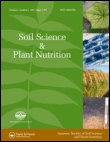
SOIL SCIENCE AND PLANT NUTRITION
Cultivating knowledge in soil science and nutrition.SOIL SCIENCE AND PLANT NUTRITION, published by Taylor & Francis Ltd, stands as a prominent journal in the fields of plant science and soil science, with its impact reflected in its Q2 ranking across both categories in 2023. Established in 1955, this journal provides a vital platform for researchers, professionals, and students dedicated to understanding the complex interactions between soil and plant nutrition, with an emphasis on advancing sustainable agricultural practices. With an impressive Scopus ranking, placing it in the 75th percentile for Plant Science and the 71st for Soil Science, it attracts high-quality, peer-reviewed articles that contribute significantly to the body of knowledge in these disciplines. While the journal does not currently offer Open Access options, its comprehensive scope encompasses studies from fundamental research to applied science, making it an essential resource for anyone engaged in soil management, agronomy, or related fields.
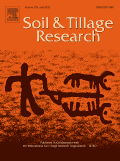
SOIL & TILLAGE RESEARCH
Elevating Knowledge on Tillage and SustainabilitySOIL & TILLAGE RESEARCH is a premier international journal dedicated to advancing the understanding of soil science and tillage practices through high-quality research and insightful reviews. Published by Elsevier and based in the Netherlands, this esteemed journal boasts impressive impact metrics, being ranked in the Q1 category across multiple domains including Agronomy and Crop Science, Earth-Surface Processes, and Soil Science, reflecting its pivotal role in the academic community. With an H-Index that underscores its citation impact and a Scopus ranking placing it in the top percentiles of its field, SOIL & TILLAGE RESEARCH serves as a vital resource for researchers and professionals focusing on sustainable agricultural practices, soil management, and environmental conservation. This journal provides a platform for open dialogue and dissemination of knowledge that shapes future research directions and policy-making in land use and sustainable agriculture.

SOIL SCIENCE SOCIETY OF AMERICA JOURNAL
Exploring the Depths of Soil DynamicsWelcome to the SOIL SCIENCE SOCIETY OF AMERICA JOURNAL, a premier publication in the field of soil science, published by WILEY. With a distinguished history dating back to 1976, this journal has consistently provided a platform for researchers to share innovative findings and insights into soil’s critical role in agricultural and ecological systems. Featuring an impressive Q1 category ranking in Soil Science and positioned within the top 25% of its field according to Scopus, this journal is recognized for its impactful contributions to advancing our understanding of soil dynamics. While not an open-access journal, it remains a valuable resource for academics and professionals alike, with distinguished articles that meet the highest scientific standards. As it enters its converged years from 1976 to 2024, the journal aims to continue shaping the future of soil research, offering valuable knowledge to students, researchers, and practitioners dedicated to sustainable land management and environmental preservation.

Soil
Empowering Sustainable Practices Through Soil ScienceSoil is a pioneering peer-reviewed journal dedicated to advancing the field of soil science, published by COPERNICUS GESELLSCHAFT MBH. Since its inception in 2015, this open-access journal has rapidly gained recognition for its high-quality research, evident in its prestigious Q1 ranking within the field and a solid position of 15 out of 159 in the Scopus rankings for Agricultural and Biological Sciences. Covering diverse aspects of soil science, including soil health, ecology, and management, Soil serves as a vital resource for researchers, professionals, and students alike, facilitating a deeper understanding of soil's critical role in the environment and agricultural productivity. With the scholarly content available freely, the journal aims to foster global collaboration and innovation in soil research, strengthening its impact in both academic and practical applications. Embrace the opportunity to contribute and engage with cutting-edge findings by submitting your work or reading the latest research in Soil.
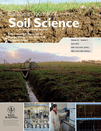
EUROPEAN JOURNAL OF SOIL SCIENCE
Pioneering Research in Soil Ecology and ManagementEUROPEAN JOURNAL OF SOIL SCIENCE, published by Wiley, stands as a leading platform in the field of soil science, recognized for its contributions to the understanding of soil ecology, management, and sustainability. With an impressive impact factor and a distinguished Q1 ranking in Soil Science, this journal has recently ranked 23rd out of 159 in its category on Scopus, placing it in the 85th percentile among its peers. Covering a wide array of topics as it converges into the future, from 1994 to 2024, the journal aims to disseminate groundbreaking research and innovative methodologies that address the pressing challenges of soil degradation and environmental sustainability in Europe and beyond. Although it is not an open access journal, the EUROPEAN JOURNAL OF SOIL SCIENCE remains a vital resource for researchers, professionals, and students seeking to deepen their understanding and explore the latest advancements in soil science.
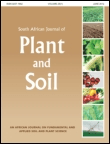
South African Journal of Plant and Soil
Innovating research for a greener tomorrow.South African Journal of Plant and Soil is an esteemed academic publication dedicated to advancing the fields of Ecology, Plant Science, and Soil Science. Published by TAYLOR & FRANCIS LTD in the United Kingdom, this journal has been a vital resource since its inception in 1984, providing a platform for innovative research and scholarly articles that address critical issues in plant and soil management. With a current impact factor placing it in the Q3 category according to the 2023 rankings, it occupies an influential position within the academic community, especially amongst researchers focused on agricultural and environmental sciences. Although not an open-access journal, it remains accessible to a broad audience through libraries and institutions that recognize its value in facilitating ecologically and environmentally focused discussions. The journal's ongoing commitment to publishing high-quality research ensures that it plays a pivotal role in nurturing knowledge and fostering advancements in sustainable practices across southern Africa and beyond.